QEII 4th Installment
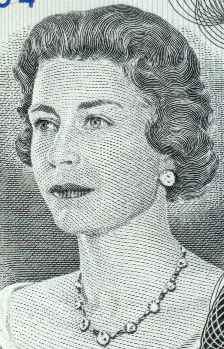
This portrait depicts Queen Elizabeth in an evening dress, wearing a diamond necklace and diamond earrings. The diamond necklace was presented to Elizabeth in April 1947, while she was still a princess, as a gift from the people of South Africa. The necklace was originally constructed with twenty-one large diamonds, connected by links that contained two small brilliant-cut diamonds mounted to either side of a baguette diamond. Shortly after Elizabeth ascended the throne, she had the necklace shortened to fifteen large stones, with the remaining stones being made into a matching bracelet. The necklace worn in this portrait is the shortened version. The earrings worn by Queen Elizabeth are Queen Mary’s Cluster Earrings, with each earring holding a large brilliant-cut diamond set in platinum and surrounded by two circles of small diamonds. The original photograph, on which the engravings are based, was an official portrait taken around 1962 by Anthony Buckley.
Date of Original Portrait: Circa 1962
Photographer: Anthony Buckley
Portrait 16aThe engraving of this portrait, which was used for the Canadian 1- and 2-dollar notes issued in 1973 and for the 20-dollar notes issued in 1969 and 1979, was executed by George Gundersen of the British American Banknote Company.
Use of this Portrait: Canada - P-85, 86, 89 and 93.
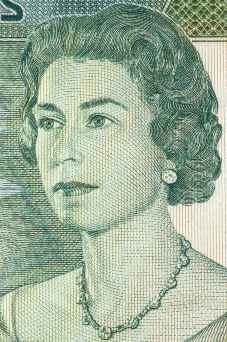
The notes of the Solomon Islands were prepared by Thomas De la Rue and this portrait is slightly different to the engraving prepared for the Canadian notes. The De La Rue image uses finer lines in the shading of the face and The Queen looks a little more severe than in the Canadian notes.
Use of this Portrait: Solomon Islands - P-5 to 12
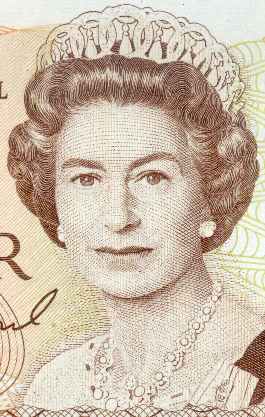
This portrait of The Queen is based on a photograph by Peter Grugeon, taken at the time of Her Majesty's Silver Jubilee in 1977, and it is one of the more popular images of The Queen. Her Majesty is depicted wearing Grand Duchess Vladimir's tiara and Queen Victoria's Golden Jubilee necklace. The tiara was smuggled out of Russia during the Russian Revolution and is now owned by The Queen. In most renditions of this portrait, the Royal Family Order of King George VI is apparent below the left-hand shoulder of Her Majesty, while the uppermost portion of the Royal Family Order of King George V is apparent in only some renditions of the portrait.
Date of Original Portrait: October 1977
Photographer: Peter Grugeon
Use of this Portrait: New Zealand -- P-169 to 176
Bermuda -- P-39
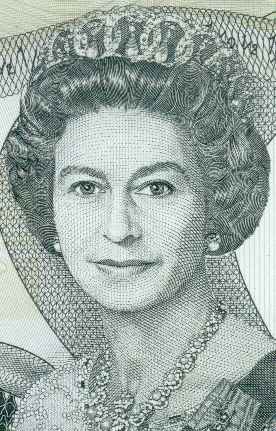
The De La Rue engraving, as well as reflecting the differences mentioned in Portrait 17a, also represents The Queen with a more cheerful aspect, achieving this through slight differences around Her eyes and lips.
Use of this Portrait:
Falkland Islands -- P-12 to 16.
Bahamas -- P-42 to 49 and 53 to 56.
East Caribbean States -- P-17 to 36.
Bermuda -- P-34 to 49.
Belize -- P-51 to 65.
Cayman Islands -- P-12 to 25.

This version of the portrait is unusual, as it is only a portion of the image used on other notes, with the tiara and the necklace not depicted. (The watermark used on the series issued in Gibraltar use the full image with tiara, as it appears in versions a and b above.) Following precedents set elsewhere, this portrait is used on a series of banknotes issued in 2010-11 -- some 33 years after the photograph was taken.
Use of this Portrait: Gibraltar -- P-35 to 39

Date of Original Portrait: 1984
Photographer: Anthony Buckley
This is one of the most informal portraits of Queen Elizabeth to be used on any banknote, and it is also one of the most flattering of the mature monarch. The engraved portrait used on the Canadian banknotes (Nos. 94, 97 and 100 in the Standard Catalog of World Paper Money) was executed by Henry S. Doubtfire of Thomas De La Rue. Adapted from an official portrait by Anthony Buckley in 1984, the engraving shows Queen Elizabeth wearing a dress with a plain neckline and wearing the necklace of three matched strings of pearls, given to her by King George V on the occasion of his Silver Jubilee, on 6 May 1935.
Use of this Portrait: Canada -- P-94, 97 and 100

Date of Original Portrait: 1978
Artist: Norman Hepple
This portrait of The Queen is copied from a painting by Norman Hepple and it is one of very few engraved images of Her Majesty to have been copied from a painting. The portrait, which shows Her Majesty attired in the regalia of the Order of the Garter, was commissioned by the States of Jersey. The original painting of Her Majesty hangs in the entrance to the Jersey States Chamber in the States Building, St. Helier, Jersey.
Use of this Portrait: Jersey -- P-15 to 25

Date of Original Portrait: 1985-86
Photographer: Don Ford
In preparation for the ‘E Series’ of notes issued by the Bank of England, photographs of The Queen were especially commissioned by the Bank. The photographs were taken by Don Ford, one of the Bank’s technical photographers, under the direction of Roger Withington. Mr. Withington designed the notes of the ‘E Series’ and prepared the engraving of the Queen, which appeared on this series of notes, from one of the photographs taken by Mr. Ford. The portrait shows Queen Elizabeth wearing Queen Mary’s ‘Girls of Great Britain and Ireland’ Tiara, Queen Alexandra’s cluster earrings and, although difficult to identify, Queen Victoria’s Golden Jubilee necklace. The ‘Girls of Great Britain and Ireland’ Tiara can be worn with or without a bandeau base and in this portrait the tiara is set into its base. (Portrait 3 shows the Tiara being worn without the base.)
Use of this Portrait: Bank of England - P-382 to 391
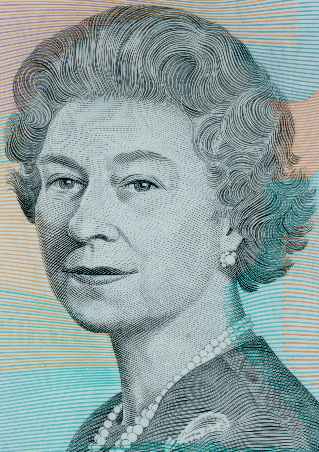
Date of Original Portrait: 1984
Photographer: John Lawrence
This informal portrait of The Queen appears on the 5-dollar note issued in Australia from July 1992. Her Majesty is shown wearing a simple dress, a string of pearls (that had come to Queen Victoria from her Hanoverian inheritance) and Queen Alexandra’s Cluster Earrings. The 5-dollar banknote was designed by Mr. Bruce Stewart and the portrait of Her Majesty is based on a photograph by John Lawrence. The portrait was commissioned by the Reserve Bank of Australia in 1984 and The Queen gave her approval for the use of this portrait on an Australian note in 1988.
Use of this Portrait: Australia -- P-50 and 51
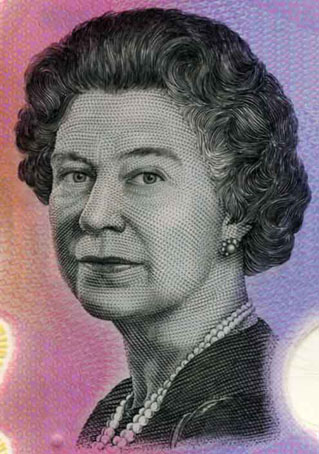
The portrait was redrawn for the second series of polymer notes in Australia. This resulted in a more pleasing fuller face and a regal gaze, directly focussed to meet the eyes of the observer.
Use of this Portrait: Australia New Issue 2016
